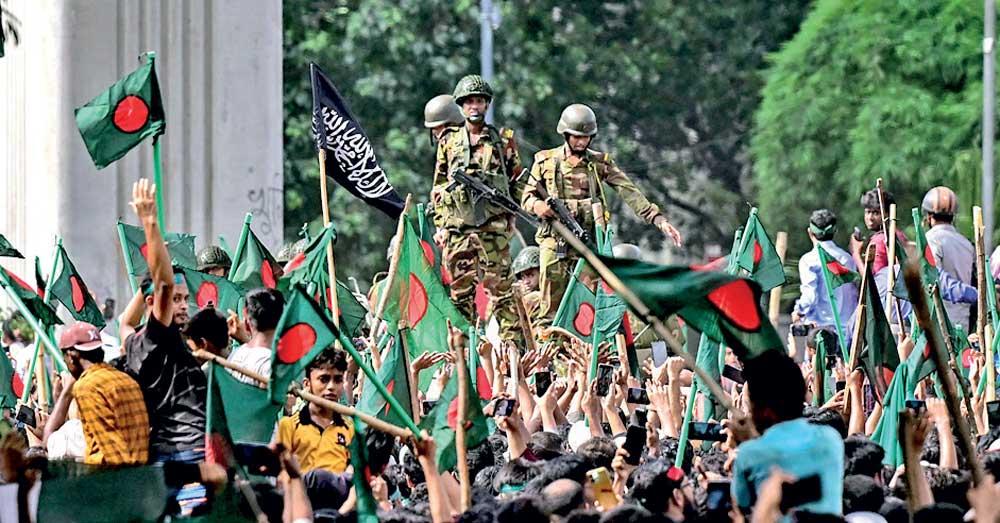Protests in Sri Lanka and Bangladesh: The bloody contrast in uncanny similarity
9 August 2024 12:10 am Views - 3187

The scenes in the streets of Dhaka were eerily similar to those in Colombo two years ago
Leave aside violence, the crisis in the two nations has identically similar roots, though immediate causes may be different

However, there is a brutal contrast in this uncanny similarity: The death count. A violent crackdown in Bangladesh killed more than 400 people in two weeks, including around 100 during the penultimate day of the protest itself.
In Sri Lanka, not a single live bullet was fired for over three months of protests, ending Gotabaya Rajapaksa’s resignation in July 2022. Isn’t that something of an accomplishment in itself?
Sri Lankan protests were largely bloodless - though not necessarily peaceful if a string of arson attacks on the residences of the ruling party parliamentarians are to be counted.
|
Sheikh Hasina
|
That restraint on the part of the government, police and the protesters themselves should be applauded. But you have not heard it from the usual speakers on the talk shows. That reluctance to appreciate what is right is a dismal feature in hyper-partisan political discourse in the country. Still, it also serves a larger purpose for like-minded usual culprits. Mention the absence of a bloodbath that would seriously erode the central premise of human rights groups, NGOs and UN bodies, whose activism in Sri Lanka is defined by single issue human rights concerns in a war fought against a terrorist group 15 years ago.
It is easier to reconcile with a president who fled without firing a shot than a prime minister who murdered hundreds in a desperate bid to cling to power. The bloodshed in Bangladesh would haunt the future, make it harder for the country to reconcile with its past, and complicate Bangladesh’s relations with India, where Hasina has taken refuge.
Similar roots
Leave aside violence, the crisis in the two nations has identically similar roots, though immediate causes may be different. In both countries, hyper-partisan, power-maximising, and increasingly authoritarian rulers have created a groundswell of discontent that was bound to explode in some way or the other. Gotabaya Rajapaksa won an election fair and square, yet he campaigned on a highly divisive, race-biting and conspiracy theory-laden platform. In Bangladesh, Hasina won an election boycotted by the main opposition after she refused to form a caretaker government before the election.
By her quest for absolutism, she made her election win a pyrrhic victory-- even though, given her track record of economic growth over the last decade, she could well have won in a freer election.
Electoral autocracies
A major concern in electoral democracy in South Asia is that electoral democracies tend to degenerate into electoral autocracies once elections are over.
That is increasingly a feature in South Asian politics, which in part could be attributed to the social and ideological origins of the contemporary leaders, from Rajapaksa to Modi to Hasina, who are not exactly the old urbanite cosmopolitans, who were bound by different values and formative experience.
The hallmarks of these electoral autocracies, such as the quest for power concentration, resultant erosion of checks and balances and dismantling of independent institutions, crony capitalism, corruption and nepotism, are omnipresent in South Asia. Both the Rajapaksas and Hasina regimes were extreme examples.
Political legitimacy
Electoral autocracies subtract a great deal of political legitimacy that the very governments had garnered through the election and create a large reservoir of grievance and anger among a sizeable population. Such discontent will explode whenever it reaches boiling point or finds a permissive context to exploit the ruler’s weakness. The Rajapaksas and Hasina were victims of their quest for political absolutism, which detached them from reality and gave them a sense of inviolability until it was too late to pull back.
These fundamental flaws resulted in them mismanaging two manageable crises: popular opposition over the government job quota in Bangladesh and economic crisis in Sri Lanka, which could have been avoided if Gotabaya listened to the saner counsels and went to the IMF. Not to mention all other egoistic blunders, such as tax cuts and a ban on chemical fertilizer, which are byproducts of a mind detached from reality.
Perhaps the greatest lesson Sri Lanka can draw from the debacle at home and further away in Bangladesh is the intrinsic limits of populist legitimacy in a constitutional government. Populist and quasi-authoritarian leaders like Rajapaksas and Hasina undermined the very foundational principles of their states to tinker with them to cater to their whims and fancies, effectively making the very governments illegitimate in the eyes of many millions of their citizens.
Gotabaya Rajapaksa is lucky enough to return to Colombo and launch his book. Still, the same could not be said about Sheikh Hasina, who might soon be back on an extradition fight to face justice unless she gets a like-minded Arab benefactor to provide her refuge.
Follow @Rangajayasuriya on X